This post is in collaboration with my friends at Stark Bro’s, my #1 online source for fruit and nut trees, shrubs and other edible plants. All opinions and words are my own.
If you’re looking for a unique fruit to add to your home garden, currants might be right up your alley (well…as long as they are legal in your area). You may see currants referred to by their type in combination with their given name in a single word, such as blackcurrant and redcurrant— this is the common spelling across the pond with our UK friends.
Are currants easy to grow? You bet, and they remain productive for as many as 20 years. Just a few plants are enough to keep your household well-stocked with delicious berries, sometimes within the same year you plant them!
Let’s dive in and check out currant varieties, plus everything you need to know to grow them, from getting them into the ground to harvesting! We’ll give you the skinny on whether or not currants are legal in your area, when and how to water, fertilize, and harvest, and equip you to deal with some common pests and diseases.
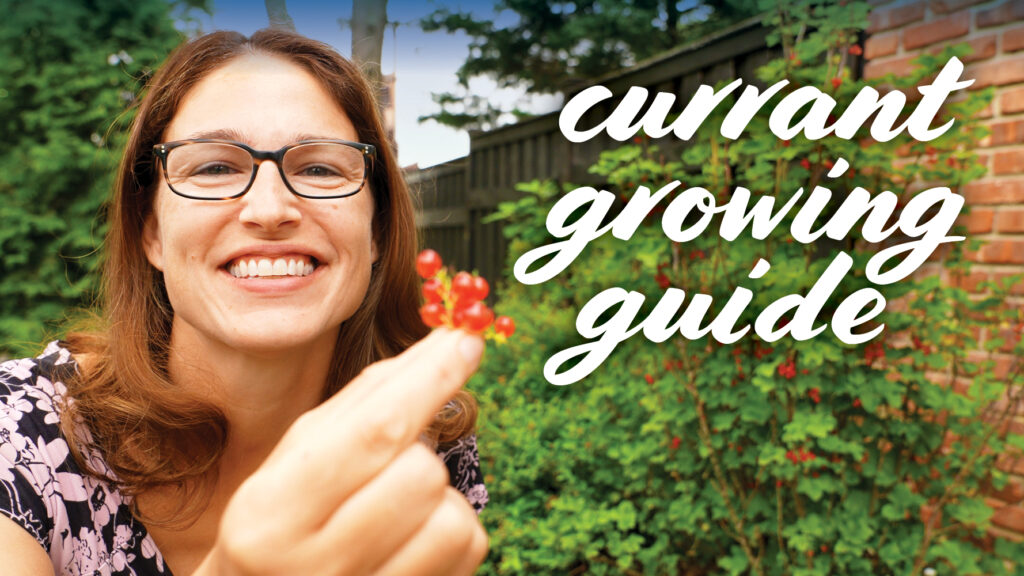
Are Currants Legal?
It may sound crazy to think that growing fruit could break the law, but depending on where you live, currants are illegal to import and grow. The reason why has to do with disease control. In the early 1900s, the US government put a federal ban on the growing of currants and their cousins, gooseberries. These species are reservoirs for white pine blister rust, a fungal disease that was wreaking havoc on the nation’s pine trees. Pine lumber was of huge economic importance at the turn of the century, and in some areas of the country, still is today. To protect the pine trees, the fruits were outlawed nationwide. The ban was rescinded in 1966, but some northern states still kept the provision in place.
To make it even trickier, some states only ban the fruit cultivation in certain areas, or limit it to certain species. Delaware and New Jersey prohibit currants and gooseberries altogether, while Massachusetts, Maine, Michigan, New Hampshire, New York, Rhode Island, and Vermont have restrictions on certain areas, certain varieties, or both. Your best bet is to double check with your state department of agriculture or a good quality nursery to get the latest information on currant restrictions for your area, before you plant and inadvertently make yourself a criminal!

What do you think about currants’ legal status? Is this something that should be revisited? Let us know in the comments!
Types of Currants
There are dozens of currant varieties to choose from, sorted into five types relative to color: black currants, red currants, white currants, pink currants, and golden currants. Red, pink, and white varieties are members of the same species, while black and gold are species all their own.
Red Currant Varieties
The red currant plant, or ribes rubrum, is often more widely available than black currants, as they are less susceptible to white pine blister rust. They are known for their tart flavor. Common choices for home gardeners are Red Lake and Red Jade.
White Currant Varieties
White currants, along with pink currants, are albino strains of the red currant species. They are less acidic than red or black currants, which some people prefer for fresh eating. Some popular varieties of the white currant plant include the Imperial White currant and White Cherry currant.
Pink Currant Varieties
Pink currants, often described as having a “blushing color” are a sweeter option for currant connoisseurs. The Pink Champagne currant is a sought-after variety.
Golden Currant Varieties
Golden currants are not only prized for their fruits, which actually fade to black when ripe, but also for their edible yellow flowers. The flowers have a spicy-sweet fragrance and taste that is described as similar to clove or vanilla. These shrubs have landscape value with their bright color and pretty fruit and flowers. Ribes aureum isn’t known for multiple varieties, but you will simply find them sold as “golden currant”.
Black Currant Varieties
The European black currant, or ribes nigrum has a bold flavor, often described as having “depth”. When ripe, the fruits are purple-black. Popular varieties include Black Consort, Crandall, and Ben Lomond.
Still looking for the perfect variety? Check out our full variety list below. What’s your favorite? And comment below if we’ve missed it!
| Variety | Fruit Color | Height/Width |
|---|---|---|
| Black Consort | black | 4-5 ft/3-6 ft |
| Crandall | black | 3-7 ft/4-6 ft |
| Seabrooks | black | 3-5 ft/3-5 ft |
| Ben More | black | 5 ft/5 ft |
| Belaruskaja | black | 4-5 ft/3-6 ft |
| Risager | black | 4-5 ft/3-5 ft |
| Hilltop Baldwin | black | 4-5 ft/5 ft |
| Prince Consort | black | 4-5 ft/3-6 ft |
| Minaj Smyriou | black | 4-5 ft/3-5 ft |
| Ben Sarek | black | 3 ft/2-3 ft |
| Ben Lomond | black | 4-5 ft/4-5 ft |
| Hill’s Kiev | black | 4-5 ft/3-5 ft |
| Otelo | black | 4-5 ft/5 ft |
| Titania | black | 4-5 ft/3-5 ft |
| Laxton’s Giant | black | 4-5 ft/4-5 ft |
| Blackdown | black | 4-5 ft/4-5 ft |
| Coronet | black | 3-5 ft/3-5 ft |
| Kirovchanka | black | 4-5 ft/3-6 ft |
| Lentaj | black | 4-5 ft/4-5 ft |
| Kantata 50 | black | 3-5 ft/3-5 ft |
| Missouri Giant | black | 4-5 ft/4-5 ft |
| Boskoop | black | 4-5 ft/4-6 ft |
| Black Topaz | black | 3-4 ft/3-5 ft |
| September | black | 4-5 ft/4-5 ft |
| Wellington XXX | black | 4-5 ft/3-5 ft |
| Red Lake | red | 4-5 ft/3-6 ft |
| Rovada | red | 3-5 ft/3-5 ft |
| Cascade | red | 3-6 ft/3-5 ft |
| Honeywood | red | 6-8 ft/3-5 ft |
| Rolam | red | 3-5 ft/3-4 ft |
| Jonkheer Van Tets | red | 3-5 ft/3-5 ft |
| Redstart | red | 3.5-5 ft/3.5-5 ft |
| Viking | red | 3-5 ft/3-4 ft |
| Rosetta | red | 3-5 ft/3-4 ft |
| Tatran | red | 3-5 ft/3-6 ft |
| Red Jade | red | 3-5 ft/3-5 ft |
| White Cherry | white | 3-5 ft/3-4 ft |
| White Imperial | white | 5-6 ft/4-5 ft |
| Blanca | white | 5 ft/2-3 ft |
| Primus | white | 5 ft/3-5 ft |
| White Pearl | white | 4 ft/4 ft |
| Zitavia | white | 6-8 ft/3-5 ft |
| Bar-le-duc | white | 3-6 ft/306 ft |
| Gloire De Sablon | pink | 3-5 ft/3-5 ft |
| Pink Champagne | pink | 3-5 ft/3-5 ft |
| Golden | Yellow/orange, then black | 4-6 ft/4-6 ft |
No matter the variety you choose, I’ve got a go-to nursery to recommend—Stark Bro’s, who I am so honored to have as the sponsor of this blog post. I’ve been buying from them for almost fifteen years, long before I had ReSprout. While I didn’t get my currant bush from Stark (that came with my house), I have been so happy with the other plants that I’ve gotten from them, including a peach tree, figs, cherries, blackberries, raspberries, apples, hundreds of strawberries—basically everything at this point!
What I love most is how user-friendly and up-to-date their website is.It’s full of plant info and super helpful filters, like zone and even taste filters. Best of all for currant lovers: they stay current (haha current!) on legal guidelines in your area, so you don’t accidentally buy something you can’t grow. They’ll help you choose a currant variety that fits your climate and the rules.
If you’re looking for healthy plants and a trustworthy source for berries, fruit trees, or edible landscaping, Stark Bro’s is my recommendation. I’m so excited to be partnering with them on this video—more from them soon!
Are Currants Self Pollinating?
Do you need two black currant plants to get fruit? Can you grow both black and red currants or will they cross pollinate and give you some mutant fruit? Don’t worry, you’re all good, because currant plants, regardless of variety, are self pollinating. Just one plant can result in currant pollination and fruit, though research has shown that having multiple plants, even of different varieties can help boost your harvests.
Where to Buy Currant Bushes
Once you are ready to start planting currants, you’ll need to pick out your planting material. There are several ways to start growing currants, some easier than others. Stark Bro’s offers both potted currants and bare-root currants, but currants can also be grown in other ways.
Growing Currants From Seed
Growing currants from seed is a complicated process. It requires a procedure known as stratification, which mimics winter dormancy to encourage seeds to grow. This a 3-4 month process that needs certain conditions maintained to be successful. Even after this procedure, germination rates can be limited. To top it off, the plants grown from seed will not necessarily reflect the characteristics of their parent plant, so your results can be skewed. It is much easier to purchase a bare root plant, potted plant, or use propagation to get your currant plants.
Currant Propagation
Currants tend to root readily via stem cuttings, so trimmings from an existing currant plan can be used to start your currant garden at home. If you have a friend with a great currant shrub, this could be a great way to go.
Potted Currants
Some retailers offer immature current bushes as a potted plant. This allows you to get a jump on growth and get more berries, sooner. You can keep growing currants in a pot, providing it has ample space for the plant as it matures. If you are moving your potted currant outside or transplanting it to the outdoors, it should go through the hardening-off process before its permanent relocation.
Bare-Root Currants
Bare-root plants are currant plants sold in dormancy, and can be stored for a period of time if needed before planting. The plant should be kept cool and moist until it is able to be planted. Before planting, the roots should be soaked in water for 3-4 hours.
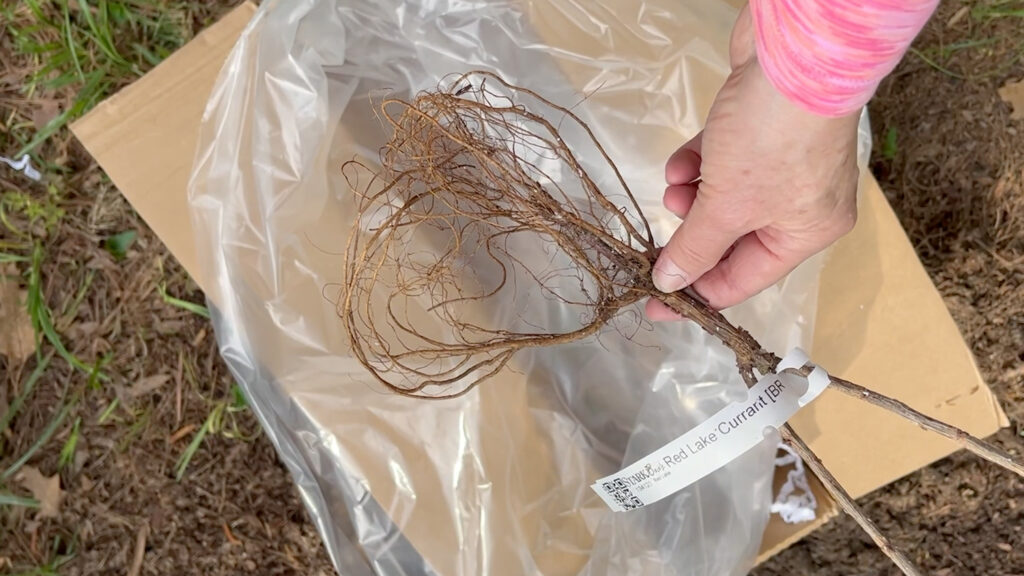
Where is the Best Place to Plant a Currant Bush?
Currants are fairly adaptable, thriving in hardiness zones from 3 to 8. However, the ideal environment for a currant bush has great air circulation, morning sun, and partial shade. The soil should be well-drained loam and heavy in organic matter. The plants appreciate a pH level of about 6.5. Varieties vary but generally range from 3-5 feet in height and width, so plan accordingly if you are adding multiple bushes. Black currant spacing requires a little more room, as these varieties tend to be larger and spread more vigorously.
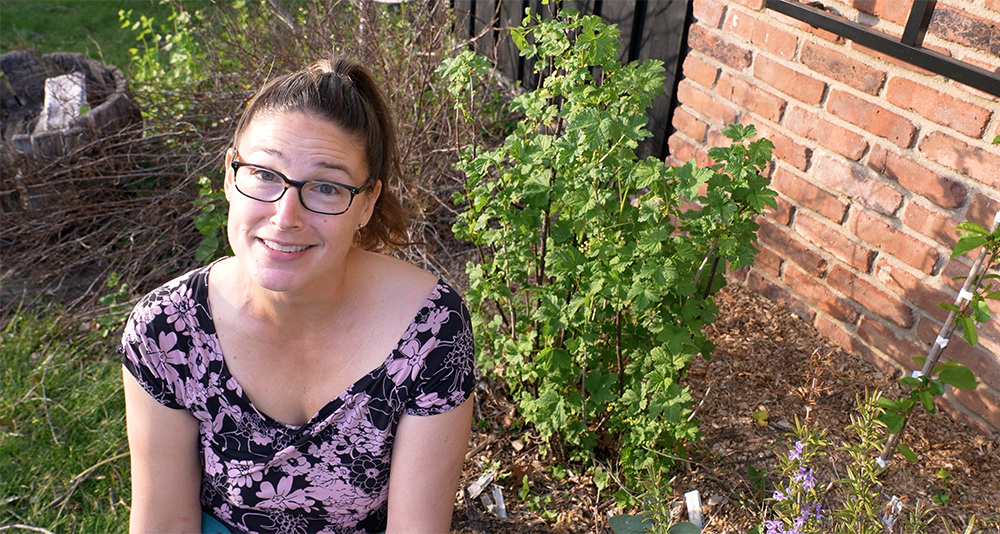
When to Plant Currants
If you are transplanting a potted plant or cutting, or planting a bare root plant, spring is generally the ideal time to plant currants. The soil should be workable, and temperatures below 20 degrees fahrenheit should have passed. Choose a dry day to do your planting, and work earlier in the day to reduce the risk of heat stress on your baby plants.
How to Plant Currants
Keep your bare roots moist and cool until planting, remember to soak them for a few hours in advance. Keep potted plants and cuttings moist. Dig a hole that is wider than your plant’s root system. Make sure the hole is deep enough to bury the root collar of the plant, about an inch deeper than your typical potted plant will arrive. This encourages the development of new roots, as will burying any low-lying branches. Water immediately after planting.
You can add mulch when planting to help cool the soil, keep weeds under control, and conserve water. 2-4 inches of wood chips, pine needles, or compost are great choices for currants.
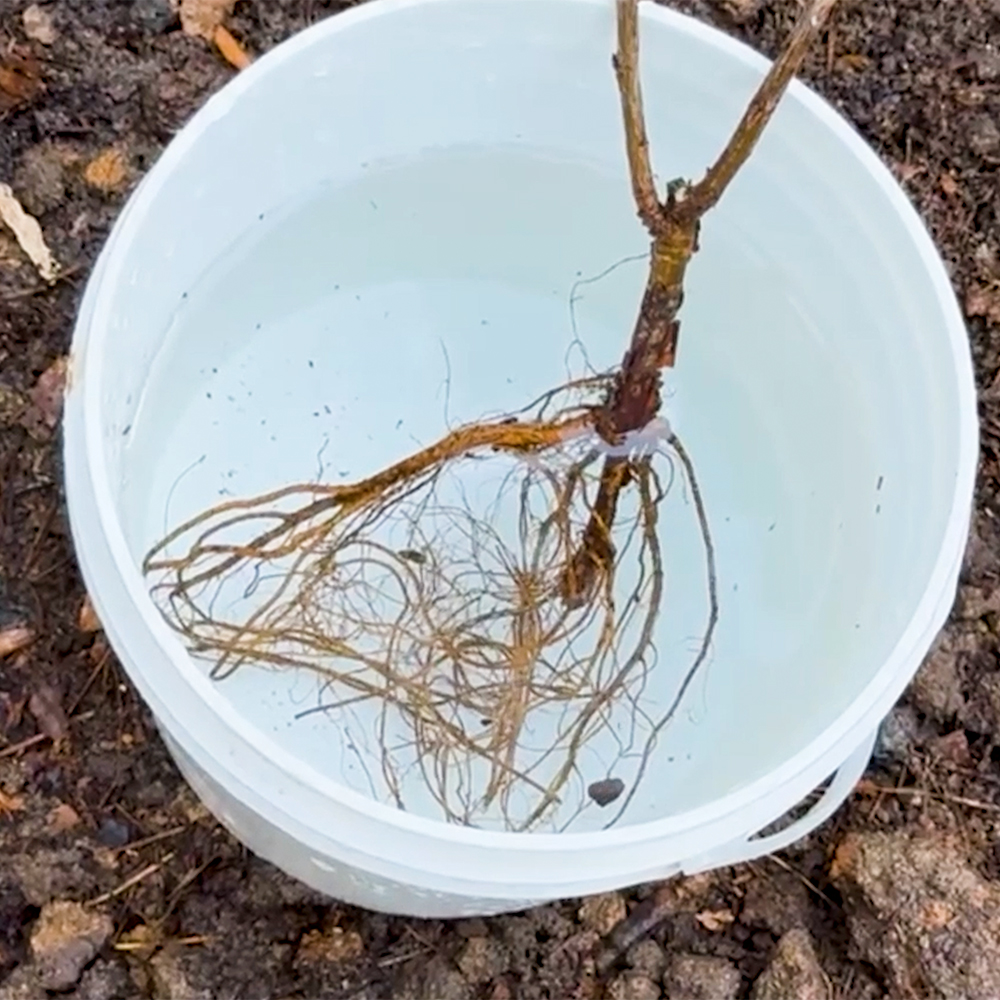
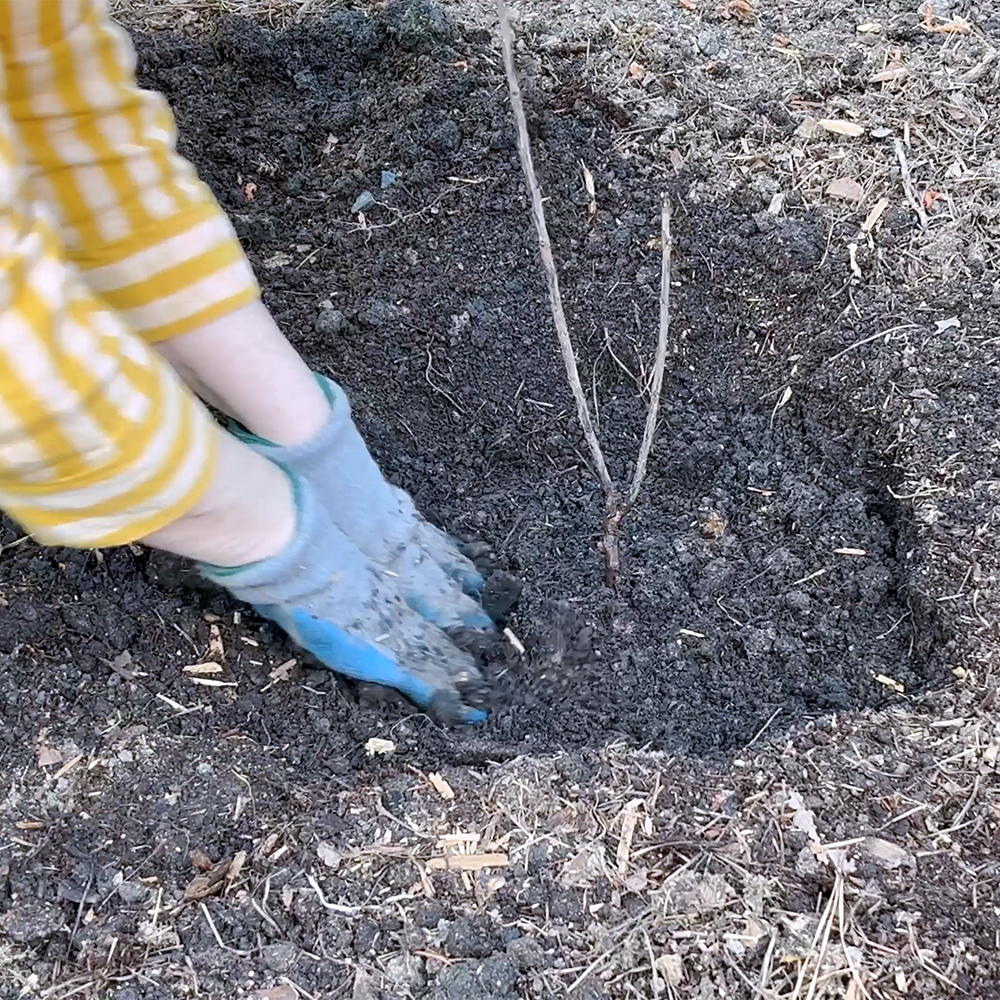
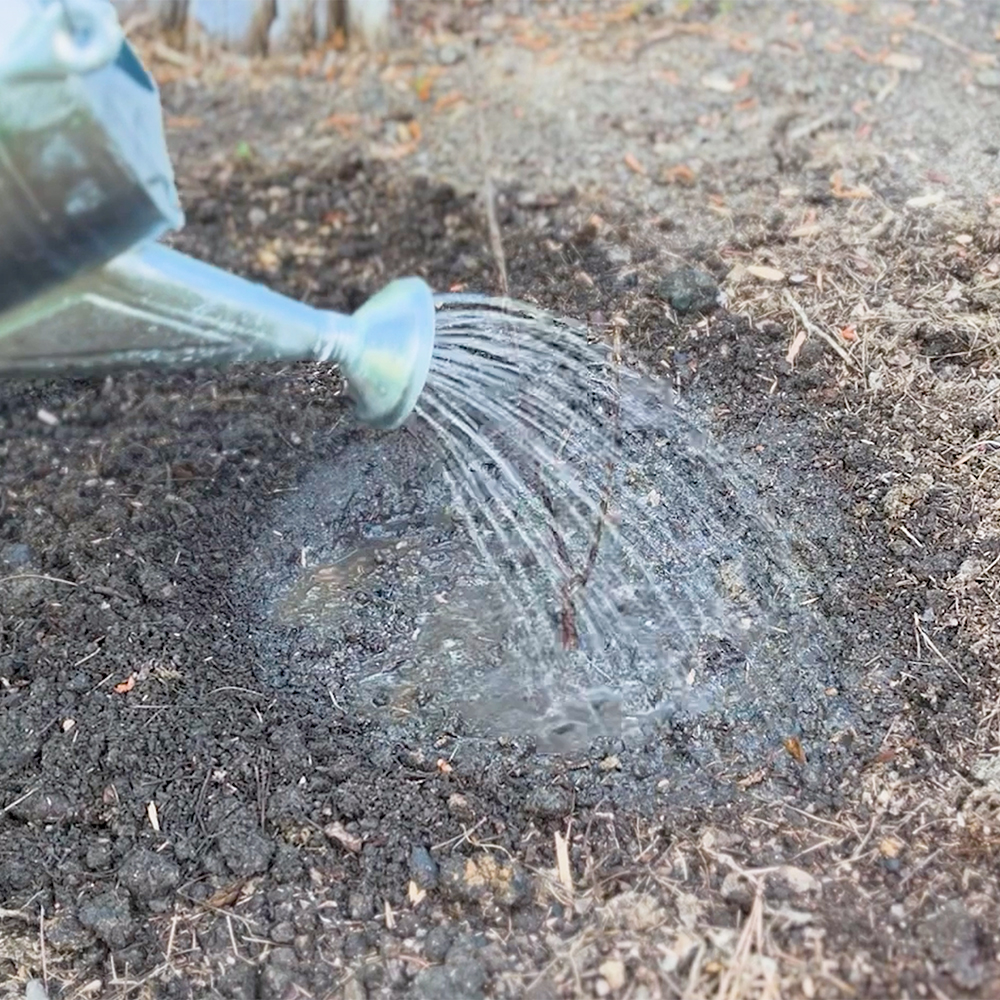
Watering Currants
Currants have shallow roots, so they do really well with drip irrigation from a soaker hose. In typical conditions, your currant plants will require 1-2 inches of water a week until harvest time.
Fertilizing & Amending Soil For Currants
Nitrogen is key for healthy currant plants, as they are considered “heavy feeders”. A good guideline is ¼-⅓ pound of 10-10-10 or 12-12-12 fertilizer per year per currant plant. Or, use slightly more of any balanced fertilizer like Down to Earth’s organic 4-4-4 fertilizer or Jobe’s 4-4-4 fertilizer. They also love well-rotted manure! However, soil testing will give you the most accurate picture of your soil health and how to fertilize.
Young plants don’t require a lot of fertilizer, but you may need to ensure that your soil is in good shape before you plant to grow healthy young currants. If, according to your soil tests, your soil is lacking in certain nutrients, add fertilizer and work it in well before planting. If your pH is too high, you can add a soil acidifier to make it more amenable to the currant plant’s needs.
Currant Diseases & Pests
Currant Aphids
Currant aphids are small green insects who feed on the plant, causing leaves to become distorted and discolored. They also leave a residue known as honeydew that soils the foliage and fruit of the plant. Fortunately, there are a number of organic treatments that are effective against currant aphids, such as neem oil, horticultural oil, or insecticidal soap.
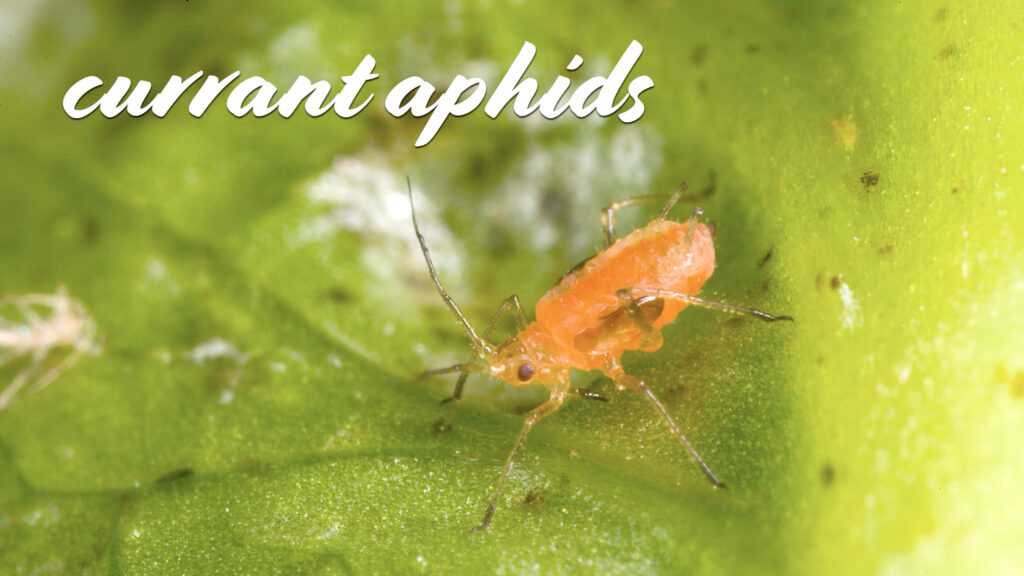
Currant Fruit Fly
Currant fruit flies live in the soil below currant bushes, emerging in spring to lay their eggs in your fruit! The developing larva will then feed on the fruit before they emerge. They can be controlled with shallow cultivation at the bases of the plants and using a floating row cover to prevent infestation.
Currant Borer
Currant borers are the offspring of Clear Wing months. You’ll spot them in the summer, and if you don’t see the larva themselves, you’ll notice yellow foliage and wilting leaves. They feed on the canes, or branches of the plant, causing weakness. You’ll want to remove any affected canes immediately.
Imported Currant Worm
Currant worms are larva that are about an inch and a half in length. They are green with a yellow end and black head. You may also observe black spots. They will strip your currant plants of foliage in no time, so it is essential to control them as soon as you spot them. Hand-pick them or use insecticidal soap.
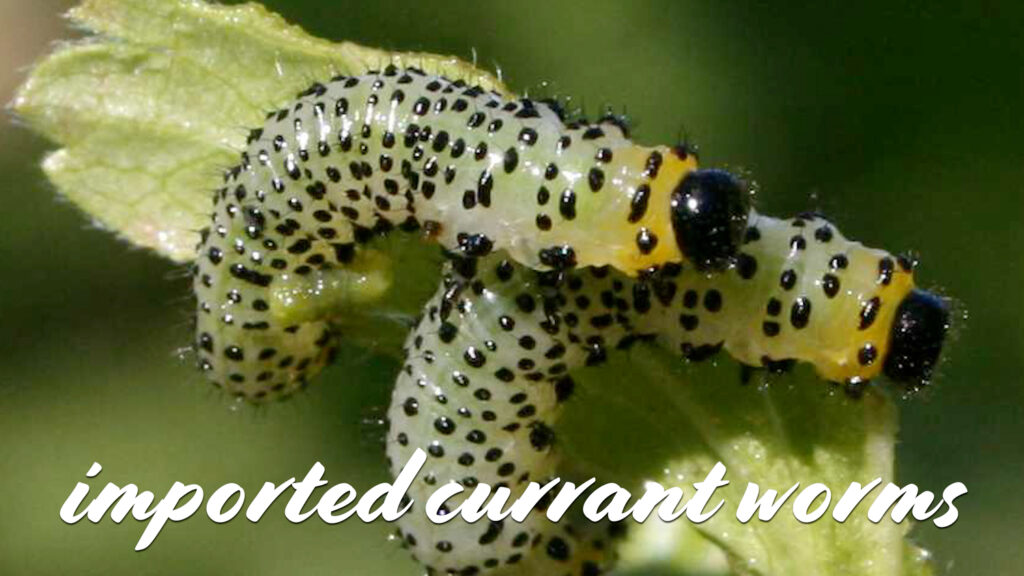
Powdery Mildew
Powdery mildew causes trademark white patches on leaves of the affected plants. Eventually the powdery white spots will turn brown. Sometimes, the spots spread to the fruit, and can stunt the plant. To reduce the occurrence of this fungus, make sure your currants have enough air circulation from appropriate spacing and pruning and keep the leaves and fruit dry.
Pruning Currants
Your currant can be pruned during its dormant periods, typically winter and early spring for most areas. After the first year of growth remove all but 6-8 vigorous shoots from the plant. The next year, leave only 4-5 best 1 year old shoots. After 3rd year, chose 3-4 adult canes to keep and trim the rest.During the fourth year, remove older canes and allow 3-4 new, strongest to grow.
From then on, keep about 8 strong canes and cycle them out every couple of years, as fruiting is strongest on 2 & 3 year old canes. Remove any dead or broken canes to reduce disease risk. Currant branches are thin enough that they can generally be handled with hand pruners, but you can use loppers if you prefer.

When to Harvest Currants
First year currant plants may produce fruit if conditions are optimal. However, their production increases yearly, with full harvests generally arriving in 4-5 years. If you are using your currants to make jam, harvest the fruits before they are fully ripened and still firm to take advantage of peak pectin levels.
Otherwise, if you plan to eat your currants fresh, harvest when ripe. At this stage, color should change depending on which type you have chosen. The fruit will separate easily from the plant when it is fully ripened. Usually peak ripeness occurs in June-July, but varies by zone and climate conditions.

How to Harvest Currants
Currants can be harvested in two ways: by hand or with a berry rake. The rake is definitely faster, but the jury’s out on whether it’s gentler on the fruit. If you choose to handpick, it can be helpful to remove an entire berry cluster at once to decrease damage potential as opposed to picking single berries.
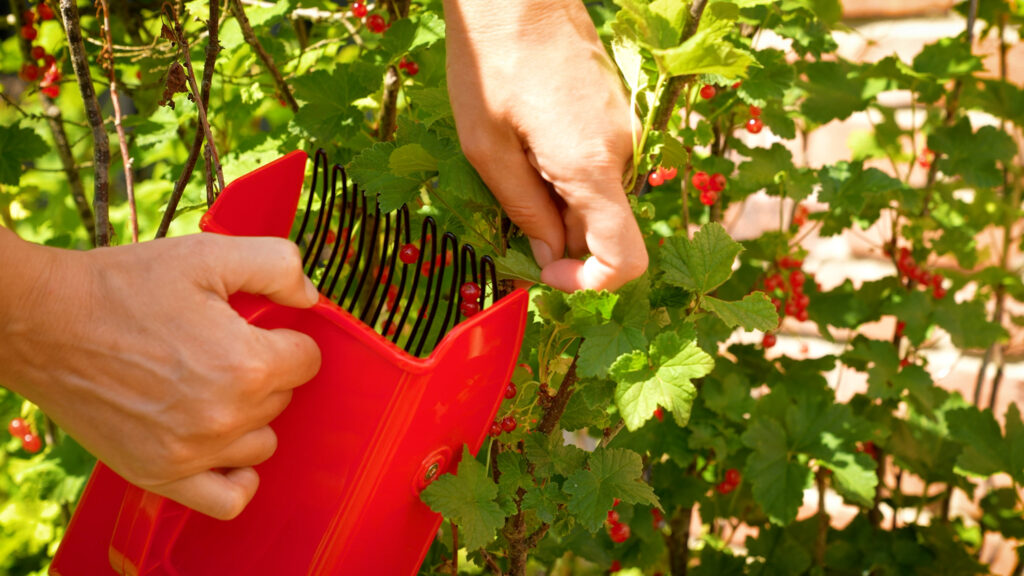
If you already have currants, do you prefer using a rake or handpicking? Let us know in the comments!
As long as planting them won’t make you a criminal in your state, currants are a low-maintenance, yet productive garden addition. When you are ready to plant, Stark Bro’s can help you find the healthiest currant plants to ensure that your foray into currant growing is a successful one!
I’ve been buying my fruit plants from them for almost fifteen years, and I don’t plan to stop anytime soon! After over 200 years in business, they are equipped to give you the most innovative varieties, with the individualized attention to detail we all love. They may be the country’s oldest continually operating nursery, but they haven’t let their success interfere with the care with which they run their family-oriented operation. Make sure you subscribe to the ReSprout newsletter to stay in the loop for the latest garden tips and upcoming Stark Bro’s collaborations!
Sources
- Currants and Gooseberries: Prohibited Towns in Massachusetts, UMass Extension Center for Agriculture.
- Growing Currants & Gooseberries in the Home Garden, University of Minnesota Extension.
- How to Grow Currant Plants, Stark Bro’s.
- How to Grow Red Currants in Your Garden, Utah State University.
- Minor Fruits: Gooseberries and Currants, Cornell University.
- Currant and gooseberry-Currant aphid, Pacific Northwest Pest Management Handbooks, Oregon State University
- Currant and gooseberry-Currant fruit fly (gooseberry maggot), Pacific Northwest Pest Management Handbooks, Oregon State University
- Gooseberry and Currant (Ribes spp.)-Powdery Mildew, Pacific Northwest Pest Management Handbooks, Oregon State University
This post is sponsored by Stark Bro’s. View the full ReSprout advertising disclosure.


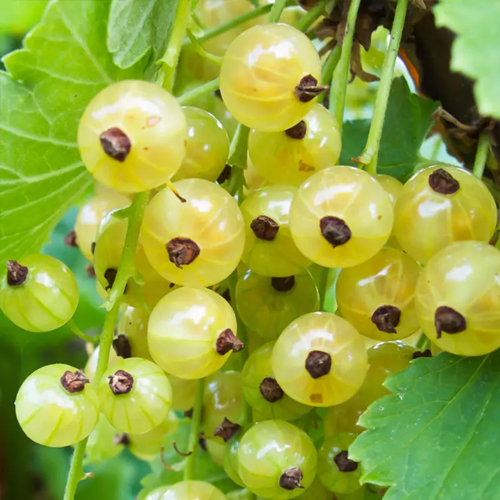
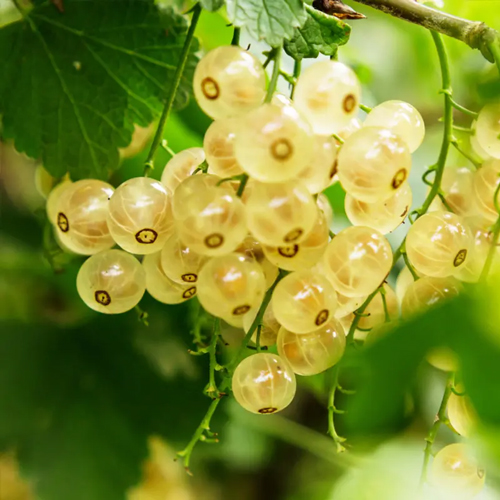



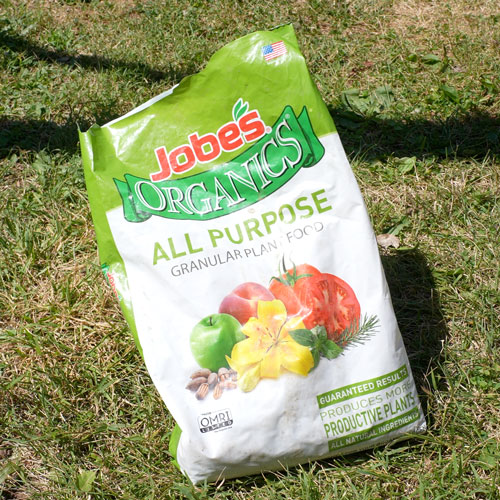
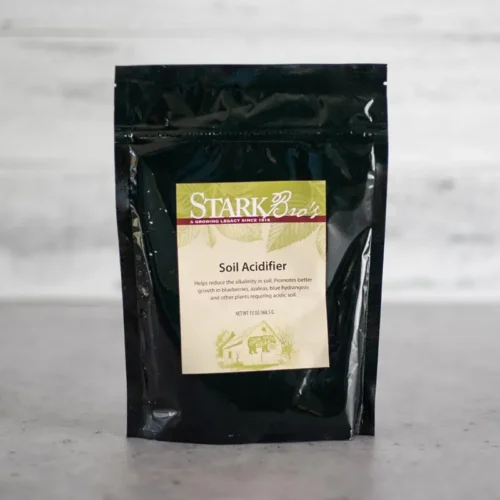
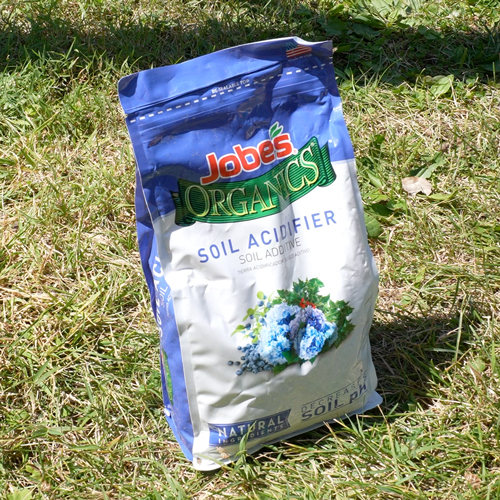
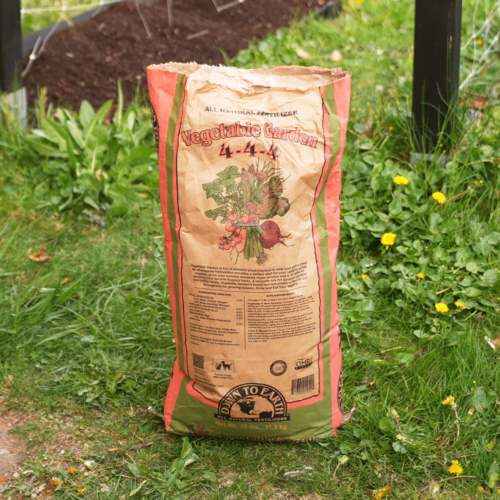

Leave a Reply